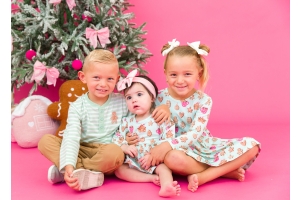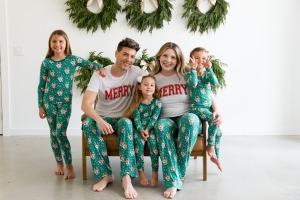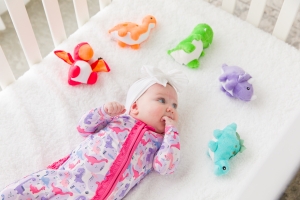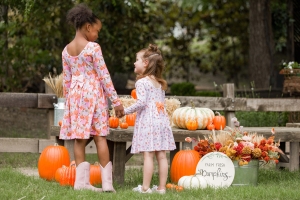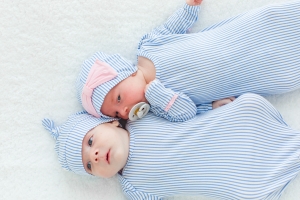When Can Babies Sleep with a Blanket?
The journey into parenthood is filled with questions, and one common worry from new and experienced parents alike is sleep safety. When can babies sleep with a blanket? When they can, what kinds of baby blankets are optimal for keeping babies safe? At RuffleButts, we understand the importance of ensuring your little one's comfort while prioritizing their safety. In this comprehensive guide, we'll dive into the topic of when babies can sleep with a blanket, explore safe sleep practices, and answer all your burning questions. So, let's embark on this journey and ensure your baby enjoys a cozy and secure night's sleep.
Understanding Baby Blanket Safety Guidelines
Before we delve into when babies can use blankets, let's talk about the significance of baby blanket safety guidelines. Creating a safe sleep environment for your infant is paramount. Blankets, while cozy, can pose risks to newborns due to the potential for suffocation or overheating. That's why organizations like the American Academy of Pediatrics (AAP) recommend avoiding blankets for newborns and transitioning to blankets at 12 months.
The Connection Between Baby Blankets and SIDS
Sudden Infant Death Syndrome (SIDS) is a concerning issue for parents, and safe sleep practices can significantly reduce the risk. Blankets in a crib can increase the risk of SIDS, as they may cover a baby's face during sleep. To protect your little one, it's crucial to follow safe sleep guidelines and keep blankets out of the crib during the early months.
Safe Sleep Practices for Newborns
When it comes to newborns, creating a safe sleep environment to keep them sleeping through the night is essential for their well-being. Here, we'll dive deeper into safe sleep practices to ensure your little one enjoys peaceful slumber while minimizing risks:
- Back to Sleep: Always place your baby on their back to sleep, as recommended by experts to reduce the risk of SIDS. Ensure that your baby's head and face remain uncovered during sleep.
- Firm Mattress: Ensure the crib mattress is firm and fits snugly in the crib.
- No Loose Bedding: Keep pillows, loose bedding, stuffed animals, and bumper pads out of the crib. A bare crib is the safest crib.
- Temperature Control: Maintain a comfortable room temperature typically around 68-72 degrees Fahrenheit (20-22 degrees Celsius). Dress your baby in light, breathable layers to prevent overheating. Overheating can increase the risk of SIDS.
- Sleep in the Same Room: The AAP recommends room-sharing without bed-sharing for the first six months to a year. Placing your baby's crib or bassinet in your room makes it easier to monitor them and tend to their needs without sharing a bed, reducing the risk of SIDS.
- Pacifiers: Once your little one has learned to successfully breastfeed, consider offering a pacifier at naptime and bedtime. Research suggests that pacifier use may reduce the risk of infant death. But if your baby refuses the pacifier, there's no need to force it.
For more methods of ensuring peaceful and healthy sleep for your baby, explore our sleep training tips and tricks.
When Can Babies Start Using Bedding?
As your baby grows, the question arises: when can babies start using blankets? Generally, it's safe to introduce a blanket to your baby's crib when they reach their first birthday. By this age, most infants have the motor skills necessary to move the blanket away from their face if it accidentally covers them during sleep.
Choosing the Right Baby Blanket
When the time is right for your baby to use a blanket, selecting the right type is essential. Opt for lightweight, breathable blankets made from materials like muslin or cotton. These materials allow for proper airflow, reducing the risk of overheating.
Small receiving blankets can be used once your baby is older and able to move the blanket if it covers their face. Additionally, when your baby has reached its first birthday, still avoid blankets with loose threads or embellishments.
Common Concerns About Baby Sleep Environment
Parents often have common concerns about their baby's sleep environment. Let's address some of these concerns and provide peace of mind:
- How do I keep my baby warm without a blanket?
You can dress your baby in layers or fleece pajamas and use a sleep sack or a wearable blanket to keep them cozy without a traditional blanket.
- Is a sleep sack safer than a blanket for my infant?
Yes, sleep sacks are a safer alternative to blankets for infants. They allow for mobility while keeping your baby warm.
- What are the alternatives to traditional baby blankets?
In addition to sleep sacks, swaddling and using baby sleeping bags are popular alternatives.
Your Guide to Providing Your Baby Safe and Cozy Slumber
Keeping your sleeping baby safe is a top priority, and with this guide, you can feel confident in knowing when babies can sleep with blankets and how to keep infants warm without them. While the optimal age for babies to sleep with a blanket is around their first birthday, it's crucial to prioritize safe sleep practices, especially during the early months. By following guidelines and choosing the right bedding, you can provide your baby with a secure and comfortable sleep environment.
And when it's time to transition from swaddles to pajamas, be sure to explore RuffleButts' delightful baby pajama collection. Our pajamas are designed with the same care, comfort, and style that you've come to expect from us. With RuffleButts, your little one can enjoy a peaceful night's sleep in cozy and adorable sleepwear. So, as you ensure a safe sleep environment, don't forget to check out our baby products and let your little one drift off to dreamland in style. Happy parenting and sweet dreams!
List of Sources:
- Shapiro-Mendoza CK, Colson ER, Willinger M, Rybin DV, Camperlengo L, Corwin MJ. Trends in infant bedding use: National Infant Sleep Position study, 1993-2010. Pediatrics. 2015 Jan;135(1):10-7. doi: 10.1542/peds.2014-1793. Epub 2014 Dec 1. PMID: 25452654; PMCID: PMC4279068.
- American Academy of Pediatrics. (2021, June 1). How to keep your sleeping baby safe: AAP policy explained. HealthyChildren.org., Retrieved January 23, 2024, from
https://www.healthychildren.org/English/ages-stages/baby/sleep/Pages/A-Parents-Guide-to-Safe-Sleep.aspx - Tips for Keeping Infants Safe During Sleep From the American Academy of Pediatrics. (2020, February 19). AAP. Retrieved January 23, 2024, from https://www.aap.org/en/news-room/news-releases/aap/2020/tips-for-keeping-infants-safe-during-sleep-from-the-american-academy-of-pediatrics/.
- Maaks, D. L., Starr, N. B., Brady, M. A., Gaylord, N. M., Driessnack, M., & Duderstadt, K. G. (2020). Burns’ pediatric primary care. (7th ed.). Elsevier.
- Psaila K, Foster JP, Pulbrook N, Jeffery HE. Infant pacifiers for reduction in risk of sudden infant death syndrome. Cochrane Database Syst Rev. 2017 Apr 5;4(4):CD011147. doi: 10.1002/14651858.CD011147.pub2. PMID: 28378502; PMCID: PMC6478106.
- Tidman, S. (n.d.). Developmental milestones - Fine motor skills: birth to 2 years. Children's Hospital of Richmond at VCU. Retrieved January 23, 2024, from https://www.chrichmond.org/services/therapy-services/developmental-milestones/fine-motor-skills-birth-to-2-years.




